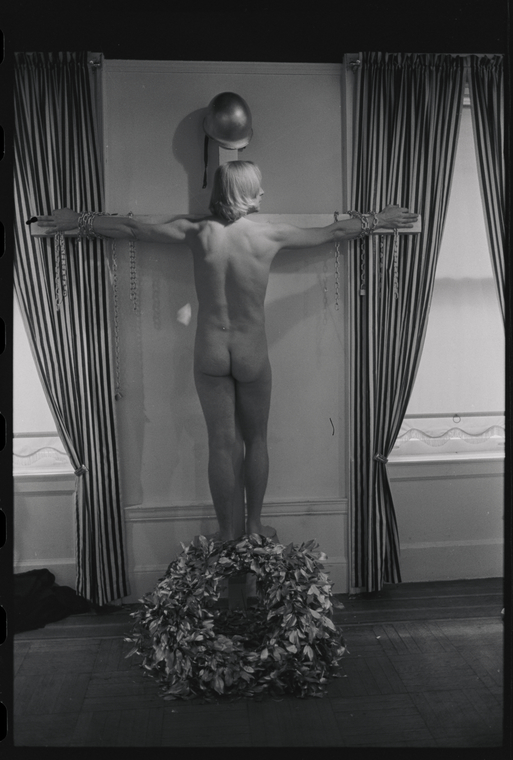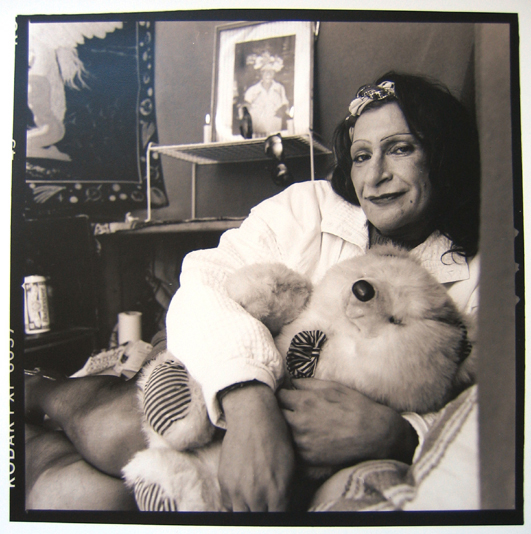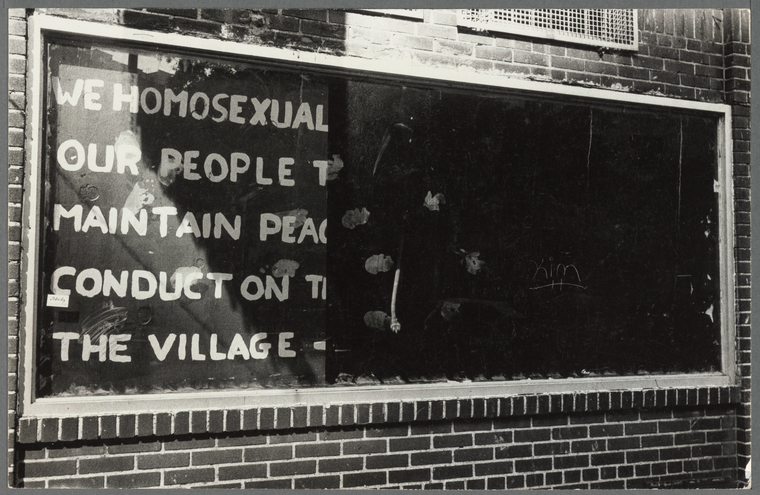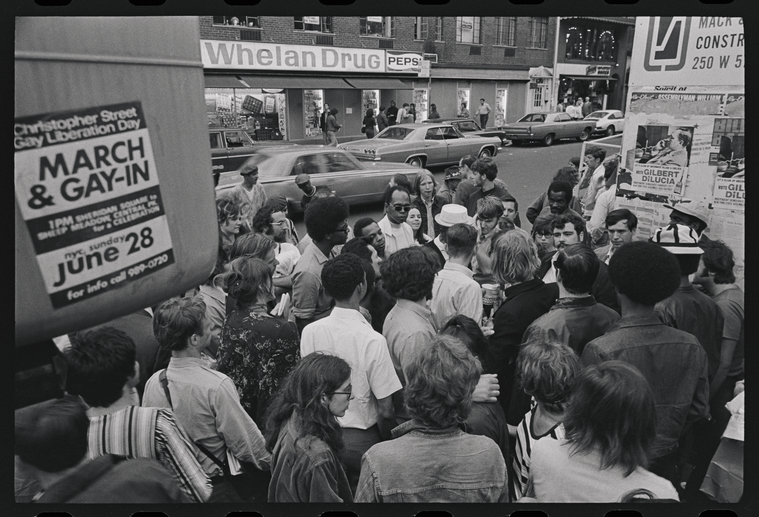Homosexuality: Sin or In?
Created by Madison Bash on Wed, 04/09/2025 - 15:26
This timeline provides a sociohistorical context for Diana Davies' 1971 photograph The Homosexual.

Manuscripts and Archives Division, The New York Public Library. ""The Homosexual" exhibition at the Gallery of Erotic Art, 1970 March" The New York Public Library Digital Collections. 1970. https://digitalcollections.nypl.org/items/ef02e570-1076-0137-7d0c-5b64fd...
Timeline
Chronological table
| Date | Event | Created by | Associated Places | |
|---|---|---|---|---|
| 1969 to 1989 |
Sylvia Rivera: From Zero to HeroThe subject appears to be Sylvia Rivera, a Puerto Rican transgender woman, who was a member of the various activist groups that Davies was also a part of. Rivera was a major participant in the Stonewall Riots. Rivera was born in 1951 and lived with her grandparents. Rivera's father was absent and her mother committed suicide when Rivera was three years old. She was beaten by her grandparents for wearing makeup and women’s clothing, so she ran from home at 11 and eventually met Marsha P. Johnson. She was part of groups like STAR and the Gay Liberation Front (GLF), which Diana Davies was a part of as well.
“Who Was Sylvia Rivera?” SRLP (Sylvia Rivera Law Project), 19 Feb. 2019, srlp.org/about/who-was-sylvia-rivera/. |
Madison Bash | ||
| 1969 to 1970 |
STAR, GLF, and MoreSTAR, or the Street Transvestite Action Revolutionaries, was a group founded by transgender activists Marsha P. Johnson and Sylvia Rivera. The goal of this organization was to provide basic necessities for trans youth who were kicked out of their homes. They provided clothing, food, and housing for teens in need. Rivera left home at 11 due to her gender identity and Johnson felt that she wasn't accepted by others in the queer circles she found herself in. This group was meant to be who Rivera and Johnson needed when they were younger. It was founded in 1970. The GLF, or Gay Liberation Front, was a group that these women as well as photographer Diana Davies was a part of. This group often attended protests and demonstrations advocating for the LGBTQ+ community. The members of the GLF were very diverse according to various photographs by Davies: men, women, transgender/non-binary/gender nonconforming, gay, lesbian, white, people of color, and more. Davies took group photos and individual photos of the group members. As previously mentioned, Davies, Rivera, and Johnson were all part of the Stonewall Riots. Rivera and Johnson were on the "front lines" and actually fighting, while Davies photographed the event and the area in which the riots occurred.
Manuscripts and Archives Division, The New York Public Library. "Stonewall Inn Window" The New York Public Library Digital Collections. 1969. https://digitalcollections.nypl.org/items/510d47e3-57d2-a3d9-e040-e00a18... |
Madison Bash | ||
| circa. 28 Jun 1969 to circa. 28 Jun 1970 |
Diana Davies' InspirationDiana Davies started to see photography as a career and less of a hobby in the 1960s. She worked for the New York Times and was sent to photograph things like war. This started her career in human rights work. She was also taking photos of and supporting the Civil Rights Movement and theater productions. Davies was present during the Stonewall Riots and is a member of the LGBTQ+ community. This specific piece, The Homosexual, was photographed mere months after the riots occurred for an exhibition of the same name. This helps the audience understand the intention behind the image. Davies did not see the LGBTQ+ community as “sinful” or “disgraceful”. She saw queer people as people. She believed that they deserved to exist and be portrayed in a positive light. Davies also worked with and knew her subject personally, so the work feels more "involved" and less like a business transaction.
Manuscripts and Archives Division, The New York Public Library. "GLF "Gay-In"" The New York Public Library Digital Collections. 1969 - 1972. https://digitalcollections.nypl.org/items/1a9e2f30-2736-0137-a21b-69759a... |
Madison Bash | ||
| 2025 |
Image Analysis and MLAThese events are crucial to the understanding of the image. While the photograph is powerful on its own with its connection to religious imagery, the audience is aided when given the context. Knowing that Diana Davies, the photographer, supported various human rights causes and built a career in photographing these events gives her a sense of authority and credibility. She isn't just photographing a naked person on the cross because she thinks it'll look good at her next exhibition. Davies' work is calculated and displays real people with real struggles. The Homosexual's religious imagery is meant to reflect what happened to Jesus. He was different from everyone else and was crucified for it. In this image, a queer person, who appears to be Sylvia Rivera, is also being "crucified". Rivera was turned away by her family and had to face the worst of the worst, but came back stronger and provided what those in need desired. Much like Jesus, she was the savior to many. This religious imagery makes more sense when we make that connection, as it solidifies Rivera's contributions to the movement. This image was taken just one year after the riots, so STAR was near its formation if it hadn't been formed already. *All photographs, other than the one of Sylvia Rivera, were taken by Diana Davies around 1969-1970. “Diana Davies Photographs.” Smithsonian Center for Folklife and Cultural Heritage, 2024, folklife.si.edu/archives-and-resources/diana-davies-photographs. “Through Diana Davies’ Lens: Capturing 1970s Radicalism | New-York Historical Society.” Www.nyhistory.org, www.nyhistory.org/blogs/through-diana-davies-lens-capturing-1970s-radicalism. Kadlec, Jeanna. “How Stonewall Broke through Barriers with Love and Resistance.” Hyperallergic, 15 Mar. 2019, hyperallergic.com/487891/love-resistance-stonewall-50-at-the-new-york-public-library/?utm_source=mutualart&utm_medium=referral. Accessed 25 Mar. 2025. “Sylvia Rivera | Biography, Speech, Stonewall, STAR, & Facts.” Encyclopedia Britannica, 9 Dec. 2024, www.britannica.com/biography/Sylvia-Rivera. Accessed 25 Mar. 2025. Rothberg, Emma. “Sylvia Rivera.” National Women’s History Museum, www.womenshistory.org/education-resources/biographies/sylvia-rivera. Accessed 9 Apr. 2025. |
Madison Bash |



